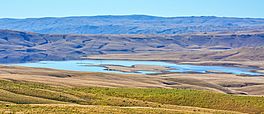Lake Onslow facts for kids
Quick facts for kids Lake Onslow |
|
|---|---|

Lake Onslow In May 2014
|
|
| Location | Otago, South Island |
| Coordinates | 45°33′S 169°37′E / 45.550°S 169.617°E |
| Type | reservoir |
| Primary inflows | Teviot River |
| Primary outflows | Teviot River |
| Basin countries | New Zealand |
| Surface elevation | 700 m (2,300 ft) |
Lake Onslow is a lake in the Otago region of New Zealand. It is a man-made lake, meaning people created it. You can find it east of Roxburgh and south of Alexandra.
The lake sits high up, about 700 meters (2,300 feet) above sea level. It was made in 1890. This happened when a dam was built across the Teviot River and an area called Dismal Swamp.
The famous artist Edward Mullor painted several pictures of Lake Onslow.
Contents
History of Lake Onslow
Lake Onslow has an interesting history, especially regarding how it might help New Zealand get electricity.
Plans for Power Generation
In 2019, a group called the Interim Climate Change Committee had an idea. They suggested using Lake Onslow for a special power system. This system is called "pumped hydro-storage."
What is Pumped Hydro-Storage?
Imagine a giant battery that uses water! That's a simple way to think about pumped hydro-storage. When there's lots of electricity, like from wind or solar, water is pumped uphill into a high lake (like Lake Onslow). When electricity is needed, the water is released. It flows downhill through turbines, which spin and create electricity. This helps provide backup power, especially in dry years when there might not be enough water for other types of hydro power.
Developing the Project
The idea for this project isn't new. A scientist named Earl Bardsley from the University of Waikato first suggested it in 2005.
In July 2020, Megan Woods, who was the Minister of Energy at the time, made an announcement. The New Zealand government decided to pay for a detailed study. This study would check if the pumped hydro-storage plan for Lake Onslow was possible.
A Big Project for New Zealand
If this project goes ahead, it would be a huge undertaking for New Zealand. It would be the biggest building project since the 1980s.
Building it would need many people, possibly between 3,500 and 4,500 workers. The construction could take about four to five years. After that, it would take another two years to fill the lake with enough water for the system to work.
One idea for the project is to store 5 TWh of energy. TWh stands for terawatt-hours, which is a very large amount of electricity. It could also have a power station that produces 1.2 GW (gigawatts) of power. This amount of power could be like half a year of full electricity production for the country.


